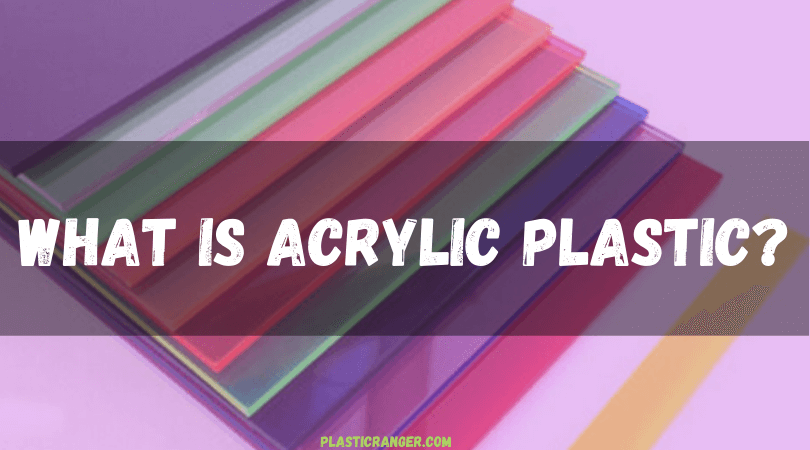Hello everybody, PMMA or Acrylic or Plexiglass is used everywhere, from our windows to sporting equipment. Let’s find out more about the infamous plastic, which is an integral part of four lives.
What is Acrylic Plastic? (PMMA)
Acrylic plastic, also known by many names like PMMA (Polymethyl methacrylate), Plexiglass, Plexiglas, etc., is a transparent thermoplastic material known by its chemical name “plexiglass,” with excellent strength, rigidity, and optical clarity. The material has many similarities with Polycarbonate and, due to its high impact resistance, is also heavily utilized as a replacement for glass.
One key difference between acrylic and polycarbonate is that the former doesn’t contain the potentially harmful substance bisphenol-A (BPA), and the latter has more significant impact strength.
The Density of acrylic is lower than polycarbonate.
The one feature differentiating acrylic from other transparent plastics is its excellent weathering properties.
Acrylic plastic sheets are easy to process and blend with organic solvents and adhesives.
The supreme optical properties make it one of the clearest plastics on the market. In addition, good transparency makes it suitable for various applications.
The melting point of acylic is 320 °F (160 °C).
Today, most acrylic plastic is sold in sheets of varying thickness depending on the applications, but it can also be found in the form of rods or tubes.
In addition, the stylized frosted, non-glare, and mirrored versions are also making the rounds in the market.
The History of Acrylic Plastic

Picture this: it’s 1843, and the first acrylic acid debuted. Fast forward to 1865, methacrylic acid, an acrylic acid derivative, enters the scene. This leads to the creation of the ester methyl methacrylate, birthed from the union of methacrylic acid and methanol.
Fast forward to 1928, a year of discovery. Multiple laboratories and pioneering chemists like William R. Conn, Otto Röhm, and Walter Bauer are cooking up something new. By 1933, German company Röhm & Haas AG, now part of Evonik Industries, introduced the world to a market-ready product trademarked as Plexiglas.
Let’s switch scenes to the early 1930s in the United Kingdom, where British chemists Rowland Hill and John Crawford at Imperial Chemical Industries (ICI) stumble upon polymethyl methacrylate. They trademark it as Perspex.
Around the same period, Otto Röhm, back in Germany, is experimenting with a blend of methyl methacrylate and glass in his quest for safety glass. He had a transparent plastic sheet, which he aptly trademarked as Plexiglas in 1933.
By the late 1930s, Perspex and Plexiglas had hit the commercial market. Not far behind, E.I. du Pont de Nemours & Company (now DuPont Company) introduces Lucite, their take on acrylic.
By 1936, ICI Acrylics, now Lucite International, began commercial production of acrylic safety glass. During World War II, acrylic glass became a critical component for Allied and Axis forces, featuring submarine periscopes and aircraft components.
Post-war, its civilian applications expanded. It’s a story of invention and reinvention, proving the timeless relevance of acrylic plastic.
How is Acrylic made?
The production of acrylic plastic begins with the gathering of the necessary raw materials. The primary ingredient is methyl methacrylate (MMA) monomer derived from natural gas or petroleum sources.
Additives and colorants may also be incorporated to enhance specific properties or introduce desired hues.
The heart of acrylic plastic production lies in the polymerization process. There are two main methods: bulk polymerization and suspension polymerization.
In bulk polymerization, MMA monomer and a polymerization initiator are placed in a reactor vessel and heated.
As the temperature rises, the MMA molecules react, forming polymer chains.
The resulting acrylic polymer becomes a solid mass. Suspension polymerization is another widely used method.
The MMA monomer is mixed with water and a suspending agent in a reactor vessel. A polymerization initiator is added, and the reactor is heated.
As the MMA droplets polymerize, they form solid particles suspended in the water.
Once the acrylic polymer is formed, it can be shaped and processed into various forms and products.
Standard methods include extrusion, injection molding, and casting. Extrusion involves forcing the molten acrylic polymer through a die, creating continuous sheets, rods, or tubes. Injection molding uses molten acrylic that is injected into a mold and then cooled and solidified.
Casting involves pouring the molten acrylic into a mold, allowing it to cool and harden into a solid sheet.
Engaging Read – Which is the Best Acrylic Glue? | The Best Plexiglass Glue
Critical Properties of Acrylic Sheets and Plastic
Acrylic has various unique properties making it ideal for a variety of applications. Here are the specific properties of acrylic (We’ll discuss the grades and properties later in the piece):
- High optical clarity
- Fantastic chemical resistance to all solvents
- Excellent dimensional stability
- Good weatherability and UV resistance
- High impact resistance
- Lightweight
| Property | Value |
| Technical name | Acrylic(PMMA) |
| Melt Temperature | 130°C (266°F) |
|
Chemical Formula
| (C5H8O2)n |
| Tensile Strength |
65 MPa (9400 PSI) ***
|
| Shrink Rate |
0.2 – 1% (.002 – .01 in/in) ***
|
| Flexural Strength |
90 MPa (13000 PSI) ***
|
| Specific Gravity | 1.18 |
|
Typical Injection Mold Temperature
|
79-107°C (175-225°F) ***
|
|
Water absorption (immersion 24 hours)
| 0.20% |
|
Light Transmittance
| 92% |
|
Heat deflection temperature
|
95°C (203°F) at 0.46 MPa (66 PSI) **
|
Why is Acrylic Used So Often?

Acrylic or Plexiglass is one of the sought-after transparent thermoplastics in the market. The optical clarity and scratch resistance make it perfect for outdoor and indoor applications.
It is a pocket-friendly, lighter alternative to glass; it is cheaper than polycarbonate and should be considered where strength is not an essential factor. It can be easily cut into precise shapes using laser energy as PMMA vaporizes in the laser’s contact.
I recommend using acrylic when optical clarity is of utmost importance; if strength is also an important factor, more preference should be given to Polycarbonate.
The Acrylic material is easily processable with injection molding, thermoforming, and extrusion.
Acrylic Grades and Applications

Acrylic or PMMA is available in various grades, each with different properties and suitable for other applications. Here are the most common acrylic plastic grades.
Extruded Acrylic
Extrudes acrylic is the commonly found grade or variation of acrylic manufactured in length resulting in cost savings as yield loss can be slashed when parts are cut from custom sheet sizes. This type of acrylic sheet blends seamlessly with cement solvents.
Cast Acrylic
Cast acrylic sheet has more excellent chemical resistance and remarkable machine processing capabilities than extruded acrylic.
Extruded and cast are the most commonly known acrylic variations. Let’s see a brief comparison between them:
Interesting Read – Plexiglass Vs. Acrylic | What are the Differences and Similarities?
Extruded |
Cast |
| Thermoformable |
Better range n terms of thickness upto 4″, especially those made for bullet resistance
|
| Phemonelol optical properties |
Better long-term resistance to UV exposure and weather
|
|
Decent electrical and UV resistance
| Lightweight and rigid |
| Impact resistance is better than glass(Not Kidding) |
Lower water absorbtion
|
Continuous Cast Acrylic
Like cast acrylic in terms of chemical resistance and machining capabilities, continuous cast acrylic provides a more defined thickness and larger, broader sheet sizes due to the continuous cast manufacturing method’s nature.
Acrylic for Architectural Applications
Acrylic’s impact resistance, lightweight, weather resistance, and, most importantly, clarity is are ideal materials for housing and office applications. It is mainly used for making windows, partitions, canopies, lighting fixtures, etc.
OPTIX® DA Acrylic for Digital Printing
OPTIX DA is extremely useful in UV protection without needing adhesion promoters.
AMGARD™ Acrylic for Safety Shields
It’s a transparent sheet coated with a silver ion antimicrobial agent that helps curb microorganisms like bacteria, mold, and fungi that will keep the product from staining and odor.
OPTIX® 95 Acrylic
OPTIX 95 is mostly used for decorative purposes as it has a matte finish. Widely used in display products it also reduces surface reflections. Stain and fingerprint resistance improves its applicability even more.
OPTIX® Flexilume Specialty Film
Another variant with a matte finish and excellent uniformity. OPTIX® Flexilume film is highly utilized as an overlapping film for lenses or as a forming insert for forming metals and profiles.
OPTIX® LD Acrylic for Light Diffusion
OPTIX® LD has supreme diffusion properties and weather resistance. Those features allow higher design flexibility with slimmer letters. Visible hot spots and splendor fluctuations are removed without affecting the light transience.
OPTIX® Pattern 12 Panels
OPTIX® pattern 12 acrylic panels for lighting provide unprecedented efficiency and reasonable glare control, not compromising the attractive appearance. The PL-21 sports a conical pattern in flexible sizes. It fits standard ceiling grids without much hassle for installation.
Fascinating Read – What is PTFE (Polytetrafluoroethylene)? | The Complete Guide
Advantages of Acrylic Plastic

- Lighter but Stronger
- Easy to Maintain
- Easy to process and Shape
Lighter but Stronger
The most significant advantage of using acrylic plastic over glass is its lightweight. It’s 50% lighter than glass but more durable and stronger. Processing acrylic in the cast or extruded form will cut costs and provide ten times more toughness than glass.
From a safety point of view, if, in any case, an acrylic sheet product breaks, it won’t shatter but will fracture into large dull(blunt) pieces.
That feature diversified its applicability to windows, shower doors, sliding doors, etc.
Easy to Maintain
As far as the cleaning and maintaining part is concerned, some usually unspoken rules must be followed. Acrylic should always be cleaned or wiped with a wet microfiber cloth.
Rough towels are also not recommended as they will create more scratches than removing them. Artificial cleaners should not be used as their chemicals will roughen the acrylic’s surface. Soapy water and Novus products will be ideal choices for cleaning.
Bonus Tip – It is recommended to clean the cloth with water to remove particles and grits because they can be responsible for leaving or enhancing the scratches on the acrylic’s surface.
Easy to Process and Shape
Acrylic plastic, when heated, becomes soft and moldable into various shapes, forms, and sizes. As it cools, it becomes hard and holds a formed shape, becoming more accessible to process in a machine.
The molds used are often made from metal or even wood. The process is inexpensive and versatile, as acrylic sheets can easily be bent into many shapes.
Disadvantages of Acrylic Plastic

- It scratches more often than glass.
- Easily stained by greases and oil. However, as I mentioned above, cleaning acrylic is also very easy.
- Distortion is another problem that can be very negative for some people because acrylic bends very easily during construction.
- Compared to thermoplastics, matte resistance is not at par.
The Most Common Plexiglass Applications
Acrylic comes with many applications, the most common: being glass display cases, bulletproof windows, skylights, etc. Below are the most common commercial and non-commercial acrylic applications.
Sporting Equipment
Ever wondered why your lightweight sports shoes make you run so fast are made up of? There are healthy chances that the sole of those shoes is made utilizing acrylic. In sports, every microsecond can make an astronomical difference; therefore, acrylic material becomes a must-use thanks to its durable yet light properties.
Acrylic is used in performance shoes, tennis racket handles, and bike helmets. After carbon fiber, acrylic is the used plastic for making sports goods.
Home Improvement
Acrylic’s transparency makes it a premium choice for the decoration furniture industry. With polycarbonate or perspex, acrylic has become an excellent alternative to glass for furniture and decoration, extensively used in cabinets, splashbacks, coffee tables, decorative panels, etc.
Aquariums
This one’s a no-brainer. The tight glass material you see in shark tanks at aquariums is often acrylic. Other materials are also used as an alternative to glass, but acrylic is the best option as it meets all the required specifications at half the price of glass.
Fiber Optic Cabling
In the past, fiber optic wiring heavily depended on the glass as the wiring tips were made from it. This was done to protect the fiber lining while still allowing light to transmit through the line and carry the data from point A to point B.
These days, the emergence of acrylic has made fiber optics realize that using acrylic makes much more sense than glass. It provides an additional benefit – acrylic remains intact when bent or stretched, where the glass breaks.
Water Resistant Paint
One of the most crucial benefits of plastic material is water-resistant. When you pour water onto a plastic surface, you will notice that it slips off from the surface. This property makes acrylic paint a great innovation. Traces of acrylic plastic added to the paint give a similar effect. Although acrylic paint is making its way to house wall paint, it is primarily used for car paint.
Fluorescent Light Lenses
Fluorescent light has come under much trouble due to its emission of many blue lights. Fluorescent lights have been linked to mental health disorders like depression, anxiety, and insomnia. Recently, acrylic plastic has been successfully formed into lenses that can fit over any fluorescent light bulb to soften the lighting and eradicate blue light.
Military Use
From breaking the sound barrier to diving deep into the ocean, acrylic has many uses for the military. Submarine windows and airplane cockpits are the most common applications for the military. Acrylic is super popular among the defense forces because of its adaptability, high strength under pressure, and transparency.
Acrylic is also heavily involved in the indoor decoration industry and is used to make plastic dentures.
Is Acrylic Toxic?

For toxicity, acrylic comes with the benefit of not containing or releasing Bisphenol A (BPA) during hydrolysis. On the other side, Polycarbonate does contain BPA. Although the overall impact of BPA is still unclear, it still gives acrylic an edge over PC.
The government research studies conclude that acrylic is toxic for humans, but as the private sector(plastic Processing companies) research goes, the government reports exaggerate the harm.
However, a safe distance between the machine and the released fumes should be maintained while processing acrylic or polycarbonate. Wearing a mask can be an excellent option to avoid fumes.
The processing should be done in a well-ventilated facility to avoid unwanted casualties.
The Future of Acrylic/Plexiglass
According to a Market Research Future study, the global Acrylic market will register a CAGR of 5.5 % and reach USD 6 billion by 2027.
The number can show drastic change because, as of writing this post, the Covid-19 pandemic is still on and has left a staggering impact on the world economy and manufacturing.
But if we look long-term, the future looks bright because of rapid acrylic adoption by various sectors worldwide. The largest consumer of acrylic is the building and architecture industry, and it will continue to hold a large chunk of the market share in the future. Acrylic’s optical clarity, transparency, chemical resistance, and lightweight make it a darling of the construction industry.
Other essential industries include communications, retail, automotive, and furniture & design. Their contribution to acrylic consumption will steadily rise in the near and long term.
The Asia-pacific region is the largest consumer of acrylic, followed by North America and Europe. However, China and India are the main markets in Asia, with more than 50% market share together in the region.
Asia-Pacific is said to keep the top spot in market share in the future, thanks to tremendous economic growth, rising purchasing power, and changing lifestyles.
FAQs
What is the molecular structure of acrylic?
(C5O2H8)n
Can plexiglass be easily shaped?
Acrylic is easy to fabricate and shape. It also has good machining properties because of its good shaping properties and its ability to become soft under high temperatures.
What is heavier? Glass or acrylic?
Glass is twice as heavy as acrylic, making acrylic ideal for many applications where the traditional choice was glass. The construction industry is an excellent example where acrylic quickly replaces glass.
Is acrylic harder than plywood?
Acrylic is said to be 30 times harder than a half-inch plywood sheet.
Is acrylic heavier than MDF?
Acrylic is denser than MDF, making acrylic at least a pound heavier. To be accurate, the acrylic platter has 0.125% wow & flutter compared to 0.175% for MDF. However, acrylic has a cleaner and more detailed sound. Acrylic is also great at decreasing unwanted vibrations because of its high density and low stiffness.
Suggested Read
- Top 5 Heat Resistant Plastic Materials | A List of High Temp Plastic Materials
- 7 Types of Plastics | An Helpful Illustrated Guide
- Top 6 Injection Molding Machine Manufacturers
- 6 Best Plastic Molding Techniques | A Complete Analysis
Summary
In conclusion, due to its distinctive properties, acrylic plastic has cemented its place as an invaluable asset in modern industries. Its transparency resembling glass, superior strength, and weather resistance make it an ideal choice for many applications. In addition, its adaptability in molding expands its usability, proving its versatility.
Moreover, it’s recyclability and non-toxic nature bolster the argument for its sustainability. Although challenges persist in production and cost, innovation continually addresses these issues. These collective attributes undeniably position acrylic plastic as an essential material contributing significantly to the evolution of our contemporary world.
I trust you’ve found this enjoyable! Don’t forget to drop your thoughts in the comment section—we’d love to hear from you!
Quick Navigation


Can I expect any more ad-ons..to this info.
Really hope. I’m doing my best in this obvious cause.
Acrylic plastic was never explained this well before.
thanks very much.
Is there any way to find an index for Acrylic (PMMA) pricing…?
WHAT is the best GLUE to use with clear acrylic photos? I want to mount them in floater wooden frames. Gorilla glue says they glue anything but gives warning about certain plastics etc.
I recently got into DIY furniture projects as a hobby, and I wanted to use glass for the cabinet I was thinking of building but hesitated in case I use it wrongly. I’m thankful you recommended we go for acrylic sheets as an alternative to glass since they are lighter and cheaper with great scratch resistance. I’ll take note of this while I go look for where I can find cut-to-size acrylic sheets for my DIY furniture projects from now on.
Glad to help! Acrylic is a versatile, durable choice for DIY projects. Good luck!
I am replacing my trailer home/manufactured home and get extreme cold, sleet, ice and winds at times at 35+/- mph. would using Acrylic sheeting, or thick panels for the broken windows work? Also get -20+ degrees in the winter. What size and thickness would you recommend?
Yes, use acrylic sheeting. Recommend 1/2 inch thickness for strength and insulation.